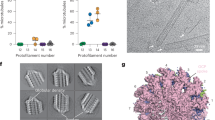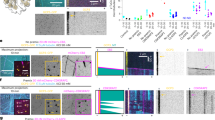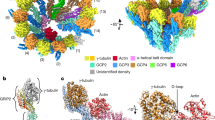Abstract
Microtubule nucleation from centrosomes involves a lockwasher-shaped protein complex containing γ-tubulin, named the γ-tubulin ring complex (γTuRC). Here we investigate the mechanism by which the γTuRC nucleates microtubules, using a direct labelling method to visualize the behaviour of individual γTuRCs. A fluorescently-labelled version of the γTuRC binds to the minus ends of microtubules nucleated in vitro. Both γTuRC-mediated nucleation and binding of the γTuRC to preformed microtubules block further minus-end growth and prevent microtubule depolymerization. The γTuRC therefore acts as a minus-end-capping protein, as confirmed by electron-microscopic examination of gold-labelled γTuRCs. These data support a nucleation model for γTuRC function that involves capping of microtubules.
This is a preview of subscription content, access via your institution
Access options
Subscribe to this journal
Receive 12 print issues and online access
$209.00 per year
only $17.42 per issue
Buy this article
- Purchase on Springer Link
- Instant access to full article PDF
Prices may be subject to local taxes which are calculated during checkout







Similar content being viewed by others
References
Burns, R. G. Identification of two new members of the tubulin family. Cell Motil. Cytoskeleton 31, 255–258 (1995).
Oakley, C. E. & Oakley, B. R. Identification of γ-tubulin, a new member of the tubulin superfamily encoded by mipA gene of Aspergillus nidulans. Nature 338, 662– 664 (1989).
Oakley, B. R. A nice ring to the centrosome. Nature 378, 555–556 (1995).
Wiese, C. & Zheng, Y. γ-Tubulin complexes and their interaction with microtubule-organizing centers. Curr. Opin. Struct. Biol. 9, 250–259 ( 1999).
Zheng, Y., Wong, M. L., Alberts, B. & Mitchison, T. Nucleation of microtubule assembly by a γ-tubulin-containing ring complex. Nature 378, 578–583 ( 1995).
Moudjou, M., Bordes, N., Paintrand, M. & Bornens, M. γ-Tubulin in mammalian cells: the centrosomal and the cytosolic forms . J. Cell Sci. 109, 875– 887 (1996).
Moritz, M., Braunfeld, M. B., Sedat, J. W., Alberts, B. & Agard, D. A. Microtubule nucleation by γ-tubulin-containing rings in the centrosome. Nature 378, 638 –640 (1995).
Moritz, M., Zheng, Y., Alberts, B. M. & Oegema, K. Recruitment of the γ-tubulin ring complex to Drosophila salt-stripped centrosome scaffolds. J. Cell Biol. 142, 775– 786 (1998).
Oegema, K. et al. Characterization of two related Drosophila γ-tubulin complexes that differ in their ability to nucleate microtubules. J. Cell Biol. 144, 721–733 (1999).
Martin, O. C., Gunawardane, R. N., Iwamatsu, A. & Zheng, Y. Xgrip109: a γ-tubulin-associated protein with an essential role in γ-tubulin ring complex (γTuRC) assembly and centrosome function. J. Cell Biol. 141, 675–687 ( 1998).
Tassin, A. M., Celati, C., Moudjou, M. & Bornens, M. Characterization of the human homologue of the yeast spc98p and its association with γ-tubulin . J. Cell Biol. 141, 689– 701 (1998).
Murphy, S. M., Urbani, L. & Stearns, T. The mammalian γ-tubulin complex contains homologues of the yeast spindle pole body components spc97p and spc98p. J. Cell Biol. 141, 663–674 (1998).
Tassin, A. M., Celati, C., Paintrand, M. & Bornens, M. Identification of an Spc110p-related protein in vertebrates. J. Cell Sci. 110, 2533–2545 (1997).
Fava, F. et al. Human 76p: a new member of the γ-tubulin-associated protein family. J. Cell Biol. 147, 857– 868 (1999).
Erickson, H. P. & Stoffler, D. Protofilaments and rings, two conformations of the tubulin family conserved from bacterial FtsZ to α/β- and γ tubulin. J. Cell Biol. 135, 5–8 (1996).
Voter, W. A. & Erickson, H. P. The kinetics of microtubule assembly. Evidence for a two-stage nucleation mechanism. J. Biol. Chem. 259, 10430–10438 ( 1984).
Mitchison, T. J. & Kirschner, M. W. Properties of the kinetochore in vitro. I. Microtubule nucleation and tubulin binding. J. Cell Biol. 101, 755–765 (1985).
Bergen, L. G., Kuriyama, R. & Borisy, G. G. Polarity of microtubules nucleated by centrosomes and chromosomes of Chinese hamster ovary cells in vitro. J. Cell Biol. 84, 151–159 ( 1980).
Byers, B., Shriver, K. & Goetsch, L. The role of spindle pole bodies and modified microtubule ends in the initiation of microtubule assembly in Saccharomyces cerevisiae . J. Cell Sci. 30, 331–352 (1978).
Weber, P. C., Ohlendorf, D. H., Wendoloski, J. J. & Salemme, F. R. Structural origins of high-affinity biotin binding to streptavidin. Science 243, 85–88 ( 1989).
Vorobjev, I. A., Svitkina, T. M. & Borisy, G. G. Cytoplasmic assembly of microtubules in cultured cells. J. Cell Sci. 110, 2635– 2645 (1997).
Yvon, A. M. & Wadsworth, P. Non-centrosomal microtubule formation and measurement of minus end microtubule dynamics in A498 cells. J. Cell Sci. 110, 2391–2401 (1997).
Keating, T. J., Peloquin, J. G., Rodionov, V. I., Momcilovic, D. & Borisy, G. G. Microtubule release from the centrosome . Proc. Natl Acad. Sci. USA 94, 5078– 5083 (1997).
McNally, F. J., Okawa, K., Iwamatsu, A. & Vale, R. D. Katanin, the microtubule-severing ATPase, is concentrated at centrosomes. J. Cell Sci. 109, 561–567 (1996).
Desai, A., Verma, S., Mitchison, T. J. & Walczak, C. E. KinI kinesins are microtubule-destabilizing enzymes. Cell 96, 69–78 (1999).
Hyman, A. et al. Preparation of modified tubulins. Methods Enzymol. 196, 478–485 ( 1991).
Murray, A. W. Cell cycle extracts. Methods Cell Biol. 36, 581–605 (1991).
Hyman, A. A. Preparation of marked microtubules for the assay of the polarity of microtubule-based motors by fluorescence. J. Cell Sci. 14 (suppl.), 125–127 (1991).
Waterman-Storer, C., Desai, A. & Salmon, E. D. Fluorescent speckle microscopy of spindle microtubule assembly and motility in living cells. Methods Cell Biol. 61, 155–173 (1999).
Evans, L., Mitchison, T. J. & Kirschner, M. W. Influence of the centrosome on the structure of nucleated microtubules. J. Cell Biol. 100, 1185– 1191 (1985).
Acknowledgements
We thank J. Heymann for encouragement to try the direct labelling method. C.W. gratefully acknowledges K. Oegema’s help with ‘microtubulology’, and M. Sepanski’s expert technical assistance with the electron microscope. We thank J. Yanowitz, J. Gall, R. Gunawardane and S. Lizarraga for critical reading of the manuscript and A. Fire for help with statistical analysis. This work was supported by a postdoctoral fellowship from the American Cancer Society to C.W., and by a Pew Scholar’s Award and NIH Grant GM56312-01 to Y.Z.
Correspondence and requests for materials should be addressed to C.W.
Author information
Authors and Affiliations
Corresponding author
Rights and permissions
About this article
Cite this article
Wiese, C., Zheng, Y. A new function for the γ -tubulin ring complex as a microtubule minus-end cap. Nat Cell Biol 2, 358–364 (2000). https://doi.org/10.1038/35014051
Received:
Revised:
Accepted:
Published:
Issue Date:
DOI: https://doi.org/10.1038/35014051
This article is cited by
-
The role of Patronin in Drosophila mitosis
BMC Molecular and Cell Biology (2019)
-
TUBG1 missense variants underlying cortical malformations disrupt neuronal locomotion and microtubule dynamics but not neurogenesis
Nature Communications (2019)
-
XMAP215 is a microtubule nucleation factor that functions synergistically with the γ-tubulin ring complex
Nature Cell Biology (2018)
-
The catalytic subunit of DNA polymerase δ inhibits γTuRC activity and regulates Golgi-derived microtubules
Nature Communications (2017)
-
Microtubule nucleation: beyond the template
Nature Reviews Molecular Cell Biology (2017)



